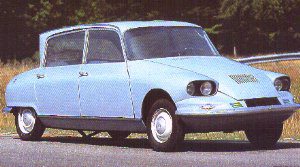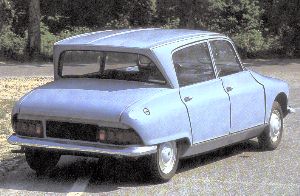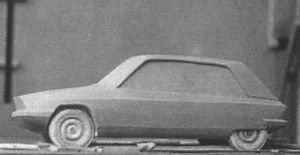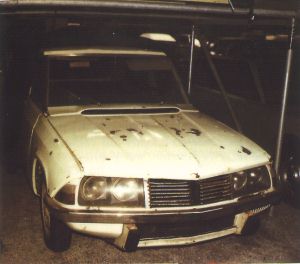Citroën GS/GSA, pre production years.
With special thanks to Julian Marsh for pictures and information
The GS was introduced by Citroën in 1970. It may be obvious that developement started some time earlier. On this page you can find some info about how development took place and under what circumstancers.
Project C
The development of the GS takes us back to 1960. Citroën was looking for a middclass car to fill up the gap between
the small 2CV and the large ID/DS. The AMI 6, introduced in 1961 was only seen as a temporary solution.
In 1960 work started on a project to fill this gap. This project, the C 60 - longer and wider than
the Ami but employing some of that car's styling elements such as the reverse rake rear window and
with a front end reminiscent of the DS, here was a singularly attractive looking car that has frequently
been misdescribed as an Ami prototype.
It would have been powered by a flat four air cooled engine of either 1.100 cc or 1.400 cc and the larger engined version would have employed hydropneumatic suspension. Development costs escalated and the decision was taken to commence a new project, project F.
Project F
Project F (also known as Projet AP) was to have been the definitive middle range CitroŽn, conceived in two
versions - one powered by a flat four, air-cooled one litre and the other by a Wankel rotary engine.
The Wankel would have had hydropneumatic suspension and powered disc brakes while the four cylinder would
have had conventional mechanical suspension. Design work started in the early sixties following the decision to
abandon Projet C.
While the use of advanced techniques such as front wheel drive and hydropneumatics had been enough to put CitroŽn at the forefront of automotive technology during the preceding thirty years, it was felt that something new was required if the company were to maintain its reputation. That something was the Wankel rotary engine and a joint venture was set up with NSU to build the powerplants. Flaminio Bertoni was responsible for the design although newcomer Robert Opron had considerable input.
A number of innovations were to be found - this would have been the first hatchback, the door frames were welded to the roof in much the manner used by the yet to be released Renault 16 and the use of four headlamps behind a glass panel anticipated the SM's styling.
Work on this project reached an extremely advanced stage and then Renault launched the almost identically styled 16. Rumours of industrial espionage abounded but were unproved. To add insult to injury, the technique for welding the roof and door frames had been patented by Renault. This must be seen in the light of Renault's blatant plagiarism of the 2 CV with their 4. The project was dropped - millions of Francs were written off and work commenced on project G.
M35
As mentioned earlier, Project F would have been equipped with a Wankel rotary engine and as
part of the test regime for that engine, a couple of hundred hydropneumatically suspended Ami coupes
were built for testing by a selected number of high mileage motorists.
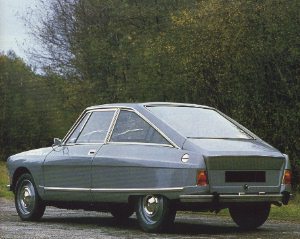
The Ami based coupe, the M35.
The M 35 was also as a test bed for the hydraulics employed in Project G. Unlike many prototypes, the M35 was available for all and sundry to view.
Project G
The car underneath, ugly as it is, is one of the first prototypes of the GS. It is obvious that it has the looks of the AMI.
In fact it is a modified AMI 6 Break, lowered en widend to fit the GS mechical. The developement of this car was called 'project G'
and the goal was again to create a new model between the lower midclass AMI and the upper midclass DS. By
now however time and money where running out for Citroën, after the two failed projects and almost ten
years later they still had not developped there middclass car.
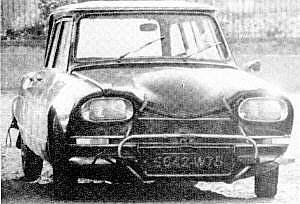
Robert Opron
A new team started to work under the leadership of the headdesigner Robert Opron. Opron, known for his no-nonsense stiff designs (leaving out chrome strips and edges)
had previously worked for Simca. After Citroën he worked for Renault, Fiat, Alfa Romeo, Ligier and Zagato. Some other cars from Oprons hand are:
- Citroën GS/GS Break
- Citroën CX/CX Break
- Citroën SM/SM Coupe/SM Presidential
- Citroën C35
- Renault Alpine V6 GT
- Renault R5 Turbo
- Renault Supercinq
- Renault Rodeo
- Renault Fuego
- Renault 25
- Renault 21
- Renault Espace
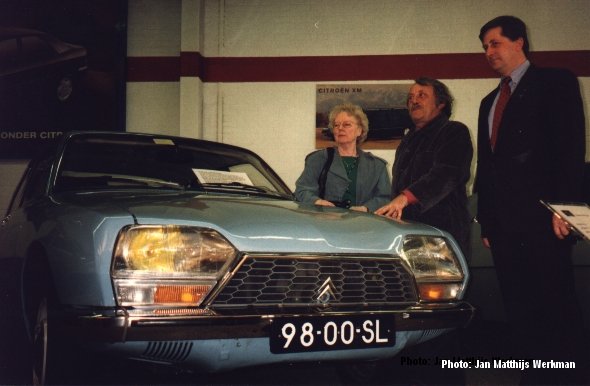
Robert Opron (middle), the designer of the GS standing next to his creation, 25 years after production started.
The only thing 'project F' had left them was a developed engine. Because of the financial concerns at Citroën at the time, they where given only six months to develop the new car. Which is very little time to develop a car and certainly back then in the earlie seventies. Remember that the GS was designed in the very beginning of the computer age. For example in promotion material, the computer Citroën used to developed the GS comes up for discussion. Mind the singular in relation to computer!
Some people would later claim, the short development time would be the main reason for several 'mechanical curiousities' in the GSs and GSAs. Anyway, as all good tales, the story did get a happy ending. The GS was introduced in 1970 and turned out to be one of the most succesfull Citroëns ever build.
1995-1998
I like to receive e-mail, therefor you are welcome to send me any message for any comments, ideas, questions or additions! I also welcome any contribution! mattysk@dds.nl

